Typical values at 25°C, AIN
= -1 dBFS, FIN = 347 MHz, FS = 1600 MSPS, High power mode, FG
calibration, JMODE 0, C-PLL off, C-PLLREF = 50 MHz and VA11Q and VCLK11
noise suppression on when C-PLL on, Quad Channel operation, nominal supply voltages,
unless otherwise noted. SNR results exclude DC and HD2 to HD9; SINAD, ENOB, and SFDR
results exclude DC.
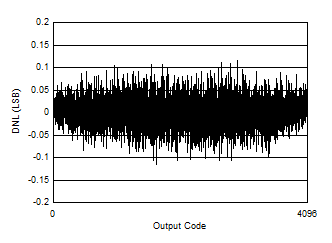 Figure 8-1 DNL
vs Code
Figure 8-1 DNL
vs Code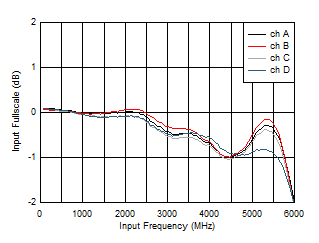 Figure 8-3 Input
Fullscale vs Frequency
Figure 8-3 Input
Fullscale vs Frequency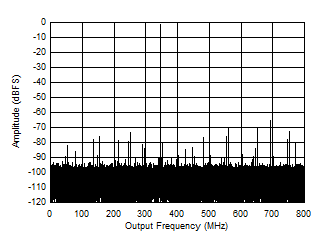
| High
power mode, C-PLL on |
Figure 8-5 Single Tone FFT at 347 MHz and -1 dBFS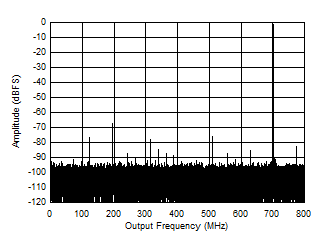 Figure 8-7 Single Tone FFT at 847 MHz and -1 dBFS
Figure 8-7 Single Tone FFT at 847 MHz and -1 dBFS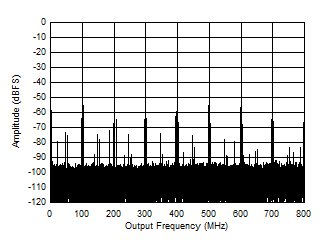
| High
power mode, C-PLL on, Noise suppression off |
Figure 8-9 Single Tone FFT at 997 MHz and -1 dBFS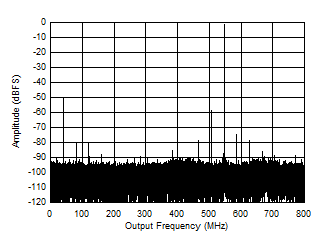 Figure 8-11 Single Tone FFT at 3797 MHz and -1 dBFS
Figure 8-11 Single Tone FFT at 3797 MHz and -1 dBFS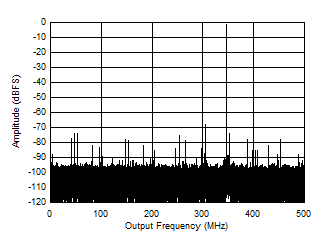
| C-PLL on, Low power mode, FS = 1000
MSPS |
Figure 8-13 Single Tone FFT at 347 MHz and -1 dBFS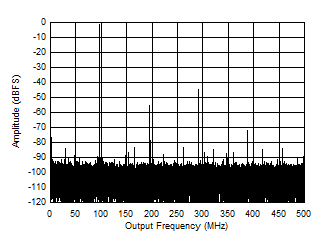
| Low
power mode, FS = 1000 MSPS |
Figure 8-15 Single Tone FFT at 2097 MHz and -1 dBFS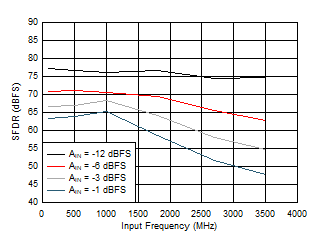 Figure 8-17 SFDR
vs Input Frequency
Figure 8-17 SFDR
vs Input Frequency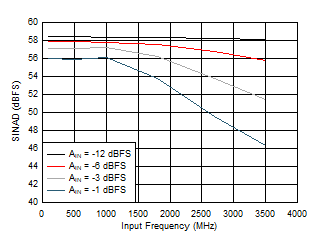 Figure 8-19 SINAD
vs Input Frequency
Figure 8-19 SINAD
vs Input Frequency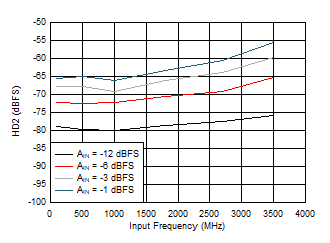 Figure 8-21 HD2
vs Input Frequency
Figure 8-21 HD2
vs Input Frequency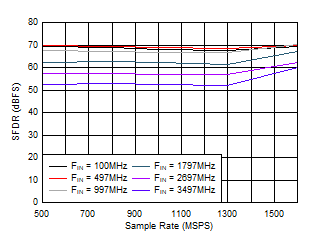 Figure 8-23 SFDR
vs Sample Rate
Figure 8-23 SFDR
vs Sample Rate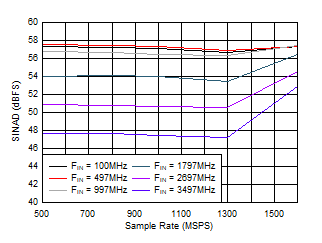 Figure 8-25 SINAD
vs Sample Rate
Figure 8-25 SINAD
vs Sample Rate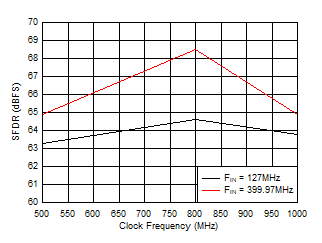 Figure 8-27 SFDR
vs Sample Rate
Figure 8-27 SFDR
vs Sample Rate Figure 8-29 SFDR
vs Sample Rate
Figure 8-29 SFDR
vs Sample Rate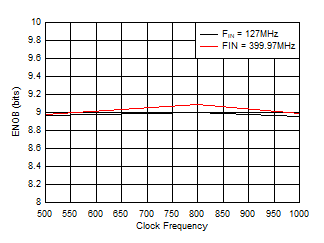 Figure 8-31 ENOB
vs Sample Rate
Figure 8-31 ENOB
vs Sample Rate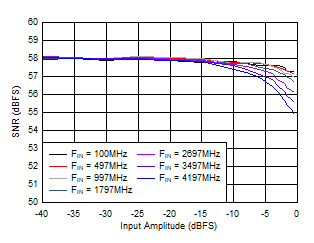 Figure 8-33 SNR
vs AIN
Figure 8-33 SNR
vs AIN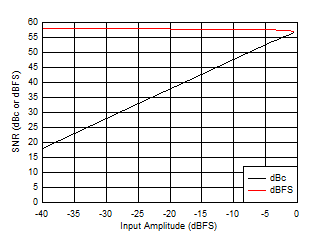
| FIN = 100MHz, Low power mode |
Figure 8-35 SNR
vs AIN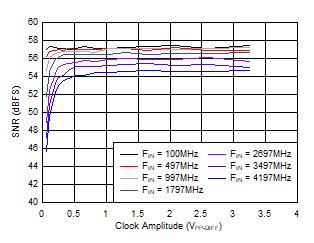 Figure 8-37 SNR
vs ACLK
Figure 8-37 SNR
vs ACLK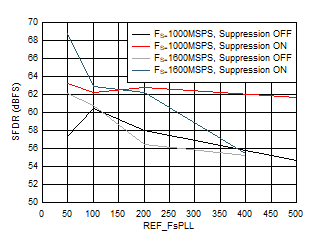 Figure 8-39 SFDR
vs FREF and Suppression
Figure 8-39 SFDR
vs FREF and Suppression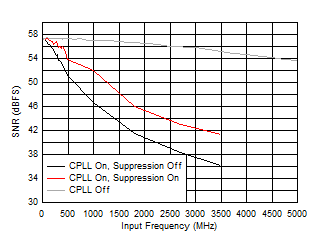 Figure 8-41 SNR
vs FIN and C-PLL modes
Figure 8-41 SNR
vs FIN and C-PLL modes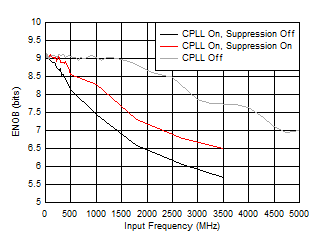 Figure 8-43 ENOB
vs FIN and C-PLL modes
Figure 8-43 ENOB
vs FIN and C-PLL modes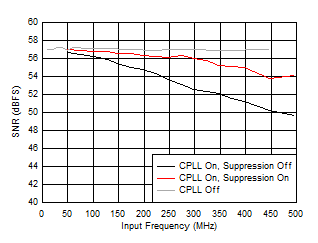 Figure 8-45 SNR
vs FIN and C-PLL modes
Figure 8-45 SNR
vs FIN and C-PLL modes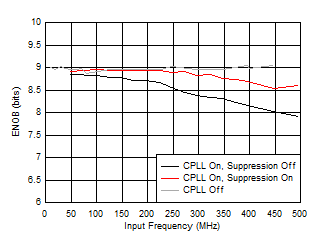 Figure 8-47 ENOB
vs FIN and C-PLL modes
Figure 8-47 ENOB
vs FIN and C-PLL modes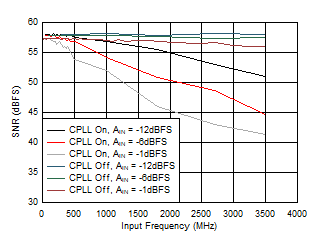 Figure 8-49 SNR
vs AIN and C-PLL
Figure 8-49 SNR
vs AIN and C-PLL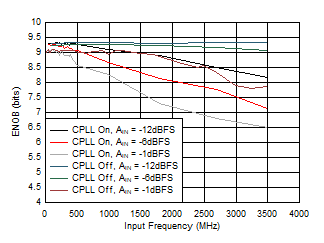 Figure 8-51 ENOB
vs AIN and C-PLL
Figure 8-51 ENOB
vs AIN and C-PLL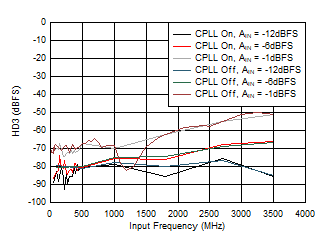 Figure 8-53 HD3
vs AIN and C-PLL
Figure 8-53 HD3
vs AIN and C-PLL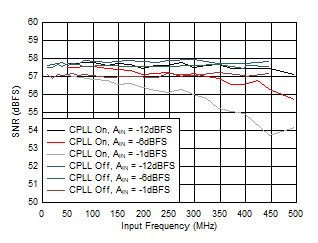 Figure 8-55 SNR
vs AIN and C-PLL
Figure 8-55 SNR
vs AIN and C-PLL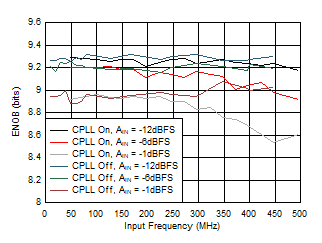 Figure 8-57 ENOB
vs AIN and C-PLL
Figure 8-57 ENOB
vs AIN and C-PLL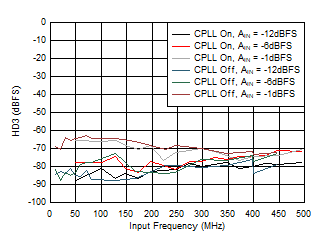 Figure 8-59 HD3
vs AIN and C-PLL
Figure 8-59 HD3
vs AIN and C-PLL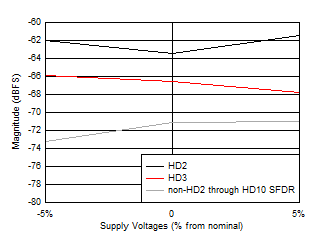
| All
supplies changed together, high power mode |
Figure 8-61 HD2,
HD3 and Worst non-HD Spur vs Supply Voltage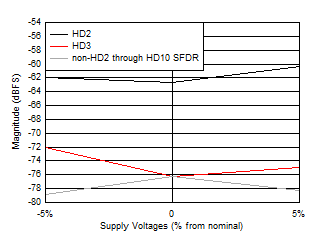
| All
supplies changed together, low power mode, FS
= 1000MSPS |
Figure 8-63 HD2,
HD3 and Worst non-HD Spur vs Supply Voltage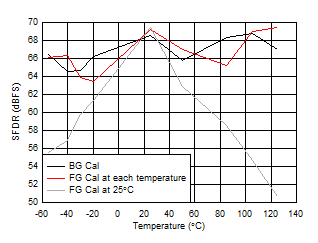 Figure 8-65 SFDR
vs Temperature
Figure 8-65 SFDR
vs Temperature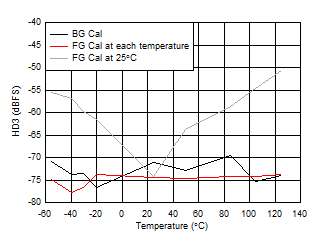 Figure 8-67 HD3
vs Temperature
Figure 8-67 HD3
vs Temperature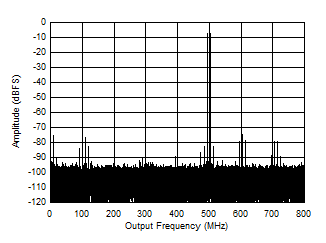 Figure 8-69 Two
Tone FFT at 498MHz
Figure 8-69 Two
Tone FFT at 498MHz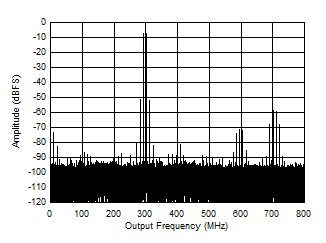 Figure 8-71 Two
Tone FFT at 3498MHz
Figure 8-71 Two
Tone FFT at 3498MHz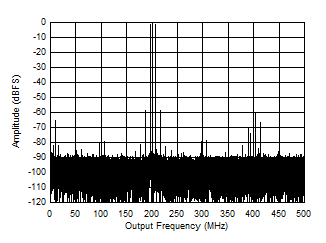
| 10
MHz tone spacing, -7 dBFS per tone, Low power mode,
1000MSPS |
Figure 8-73 Two
Tone FFT at 1798 MHz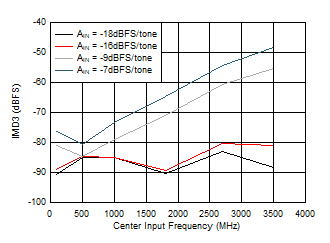 Figure 8-75 IMD3
vs FIN
Figure 8-75 IMD3
vs FIN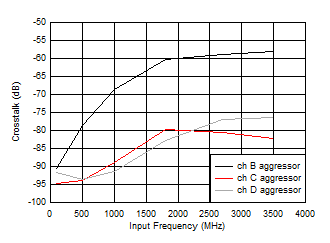 Figure 8-77 Crosstalk to Channel A vs FIN
Figure 8-77 Crosstalk to Channel A vs FIN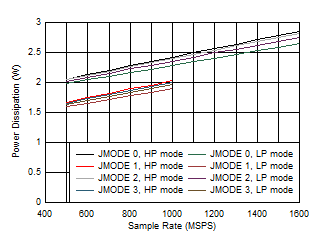
| Low
power background calibration mode |
Figure 8-79 Quad
Channel, Power Dissipation vs FS and JMODES 0 - 3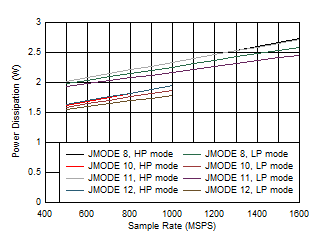
| Low
power background calibration mode |
Figure 8-81 Quad
Channel, Power Dissipation vs FS and JMODE 8 - 12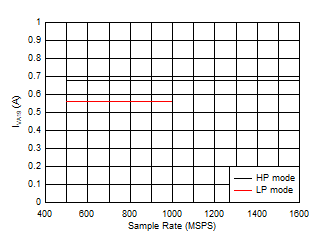
| Low
power background calibration mode, independent of
JMODE |
Figure 8-83 Quad
Channel, IVA19 vs FS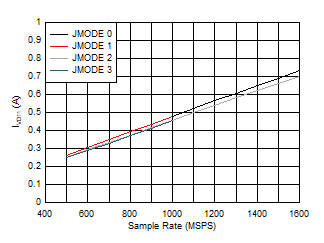
| Low
power background calibration mode, independent of power
mode |
Figure 8-85 Quad
Channel, IVD11 vs FS and JMODE 0 - 3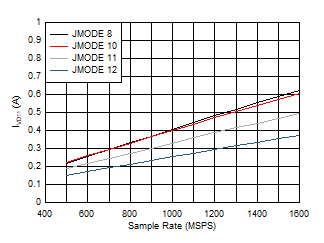
| Low
power background calibration mode, independent of power
mode |
Figure 8-87 Quad
Channel, IVD11 vs FS and JMODE 8 - 12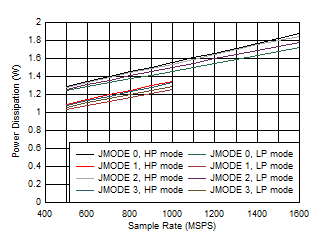
| Low
power background calibration mode |
Figure 8-89 Dual
Channel, Power Dissipation vs FS and JMODE 0 - 3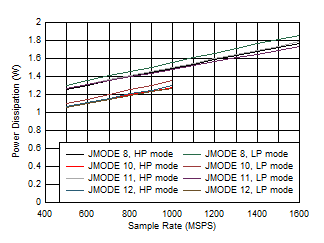
| Low
power background calibration mode |
Figure 8-91 Dual
Channel, Power Dissipation vs FS and JMODE 8 - 12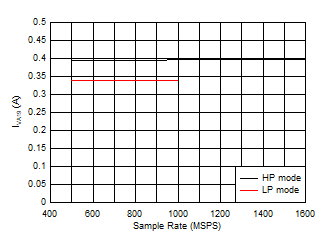
| Low
power background calibration mode, independent of
JMODE |
Figure 8-93 Dual
Channel, IVA19 vs FS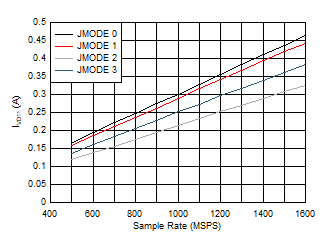
| Low
power background calibration mode, independent of power
mode |
Figure 8-95 Dual
Channel, Power Dissipation vs FS and JMODE 0 - 3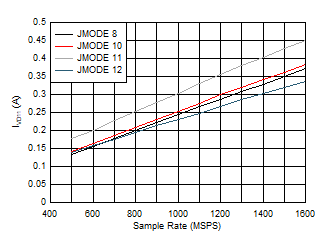
| Low
power background calibration mode, independent of power
mode |
Figure 8-97 Dual
Channel, Power Dissipation vs FS and JMODE 8 - 12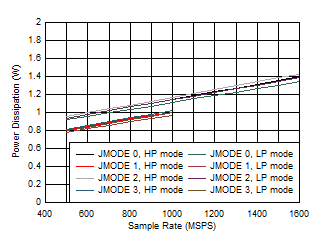
| Low
power background calibration mode |
Figure 8-99 Single Channel, Power Dissipation vs FS and JMODE 0 - 3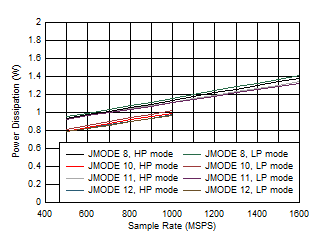
| Low
power background calibration mode |
Figure 8-101 Single Channel, Power Dissipation vs FS and JMODE 8 - 12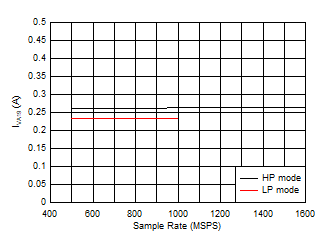
| Low
power background calibration mode, independent of
JMODE |
Figure 8-103 Single Channel, IVA19 vs FS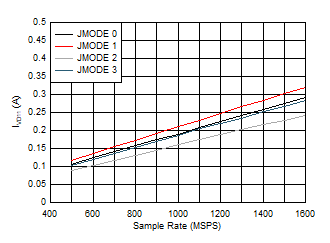
| Low
power background calibration mode |
Figure 8-105 Single Channel, IVD11 vs FS and JMODE 0 - 3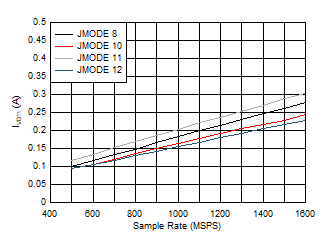
| Low
power background calibration mode |
Figure 8-107 Single Channel, IVD11 vs FS and JMODE 8 - 12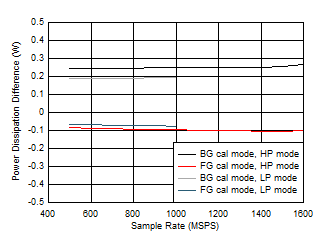
| Difference to lower power background calibration, JMODE
independent |
Figure 8-109 Quad
Channel, Power Dissipation Change with Calibration Mode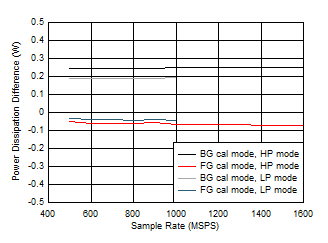
| Difference to lower power background calibration, JMODE
independent |
Figure 8-111 Single Channel, Power Dissipation Change with Calibration Mode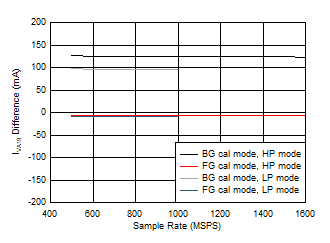
| Difference to lower power background calibration, JMODE
independent |
Figure 8-113 Dual
Channel, IVA19 Change with Calibration Mode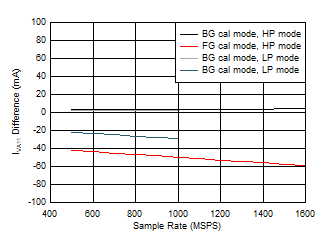
| Difference to lower power background calibration, JMODE
independent |
Figure 8-115 Quad
Channel, IVA11 Change with Calibration Mode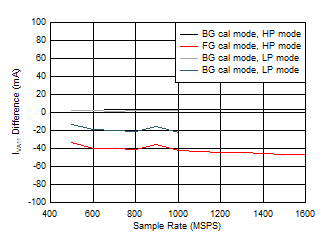
| Difference to lower power background calibration, JMODE
independent |
Figure 8-117 Single Channel, IVA11 Change with Calibration Mode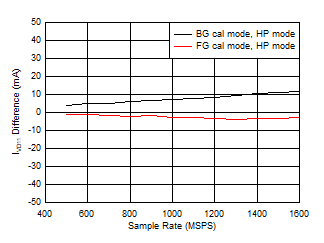
| Difference to lower power background calibration, JMODE
independent |
Figure 8-119 Dual
Channel, IVD11 Change with Calibration Mode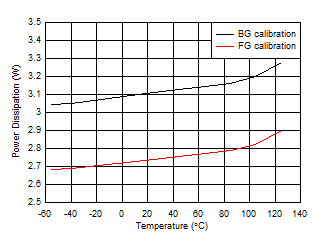 Figure 8-121 Quad
Channel, Power Dissipation vs Temperature
Figure 8-121 Quad
Channel, Power Dissipation vs Temperature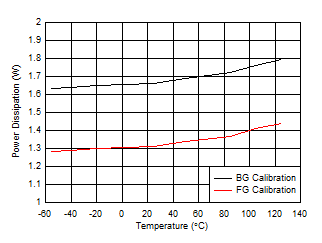 Figure 8-123 Single Channel, Power Dissipation vs Temperature
Figure 8-123 Single Channel, Power Dissipation vs Temperature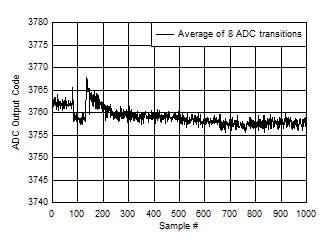
| BG
Calibration, input voltage offset ~ 90% of fullscale,
ADC_SRC_DLY=31, MUX_DLY=30 |
Figure 8-125 Background Calibration Core Transition (offset voltage)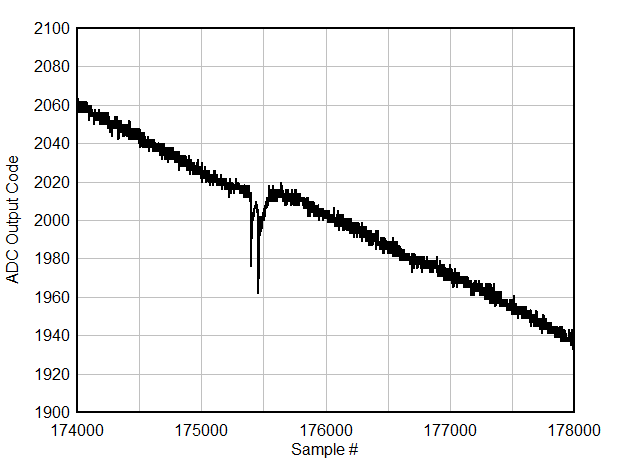
| BG
Calibration, ADC_SRC_DLY=31, MUX_DLY=30, unzoomed region
shown in previous plot |
Figure 8-127 Background Calibration Core Transition (AC Signal Zoomed)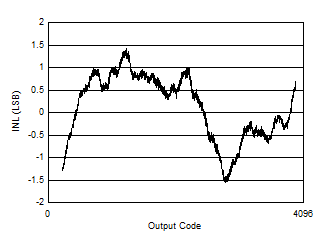 Figure 8-2 INL
vs Code
Figure 8-2 INL
vs Code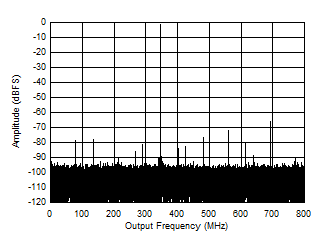 Figure 8-4 Single Tone FFT at 347 MHz and -1 dBFS
Figure 8-4 Single Tone FFT at 347 MHz and -1 dBFS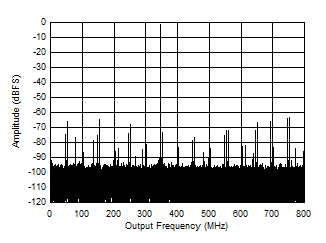
| High
power mode, C-PLL on, Noise suppression off |
Figure 8-6 Single Tone FFT at 347 MHz and -1 dBFS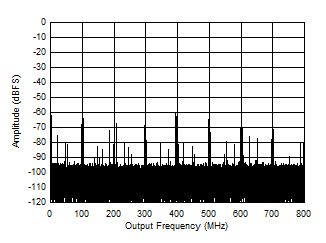
| High
power mode, C-PLL on |
Figure 8-8 Single Tone FFT at 997 MHz and -1 dBFS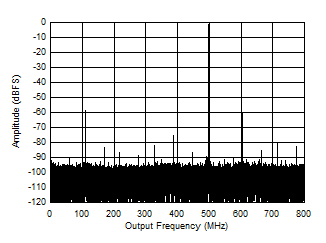 Figure 8-10 Single Tone FFT at 1797 MHz and -1 dBFS
Figure 8-10 Single Tone FFT at 1797 MHz and -1 dBFS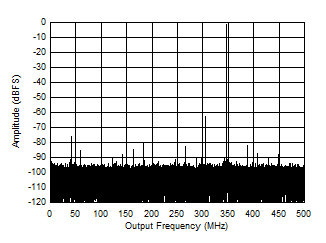
| Low
power mode, FS = 1000 MSPS |
Figure 8-12 Single Tone FFT at 347 MHz and -1 dBFS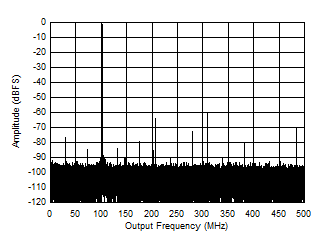
| Low
power mode, FS = 1000 MSPS |
Figure 8-14 Single Tone FFT at 897 MHz and -1 dBFS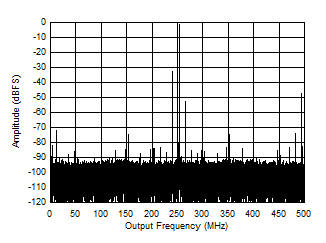
| Low
power mode, FS = 1000 MSPS |
Figure 8-16 Single Tone FFT at 3797 MHz and -1 dBFS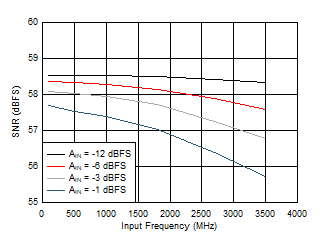 Figure 8-18 SNR
vs Input Frequency
Figure 8-18 SNR
vs Input Frequency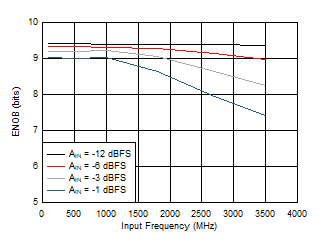 Figure 8-20 ENOB
vs Input Frequency
Figure 8-20 ENOB
vs Input Frequency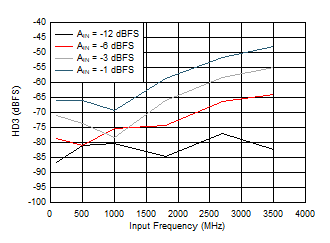 Figure 8-22 HD3
vs Input Frequency
Figure 8-22 HD3
vs Input Frequency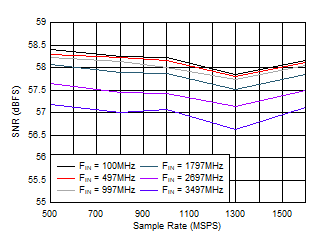 Figure 8-24 SNR
vs Sample Rate
Figure 8-24 SNR
vs Sample Rate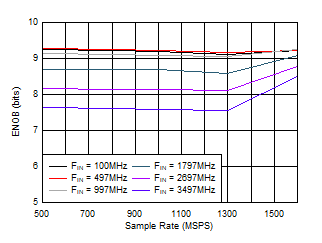 Figure 8-26 ENOB
vs Sample Rate
Figure 8-26 ENOB
vs Sample Rate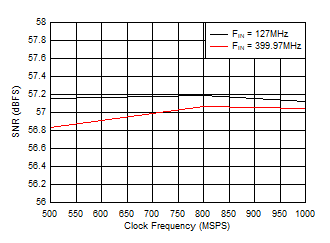 Figure 8-28 SNR
vs Sample Rate
Figure 8-28 SNR
vs Sample Rate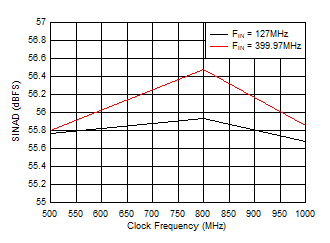 Figure 8-30 SINAD
vs Sample Rate
Figure 8-30 SINAD
vs Sample Rate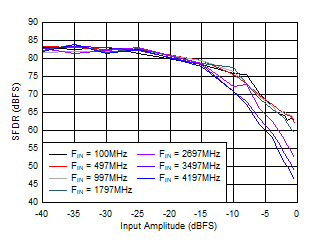 Figure 8-32 SFDR
vs AIN
Figure 8-32 SFDR
vs AIN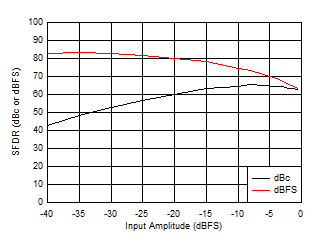
| FIN = 100MHz, Low power mode |
Figure 8-34 SFDR
vs AIN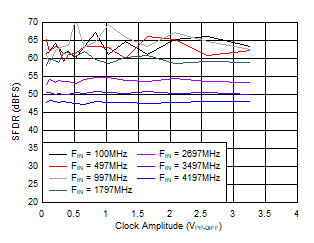 Figure 8-36 SFDR
vs ACLK
Figure 8-36 SFDR
vs ACLK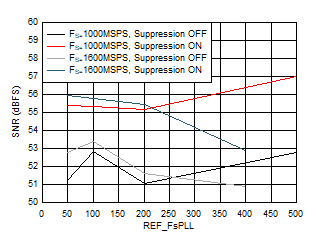 Figure 8-38 SNR
vs FREF and Suppression
Figure 8-38 SNR
vs FREF and Suppression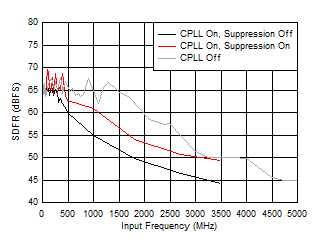 Figure 8-40 SFDR
vs FIN and C-PLL modes
Figure 8-40 SFDR
vs FIN and C-PLL modes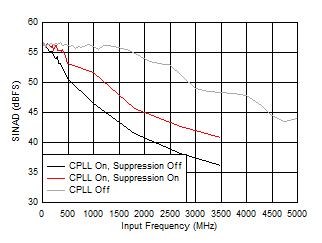 Figure 8-42 SINAD
vs FIN and C-PLL modes
Figure 8-42 SINAD
vs FIN and C-PLL modes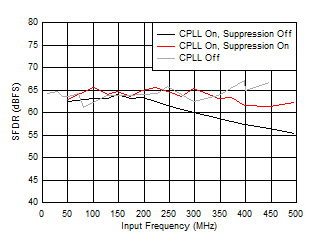 Figure 8-44 SFDR
vs FIN and C-PLL modes
Figure 8-44 SFDR
vs FIN and C-PLL modes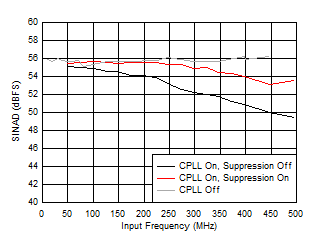 Figure 8-46 SINAD
vs FIN and C-PLL modes
Figure 8-46 SINAD
vs FIN and C-PLL modes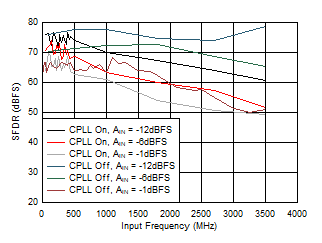 Figure 8-48 SFDR
vs AIN and C-PLL
Figure 8-48 SFDR
vs AIN and C-PLL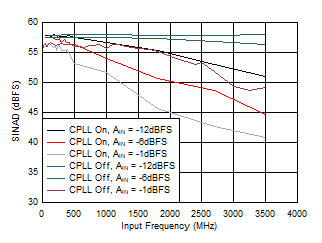 Figure 8-50 SINAD
vs AIN and C-PLL
Figure 8-50 SINAD
vs AIN and C-PLL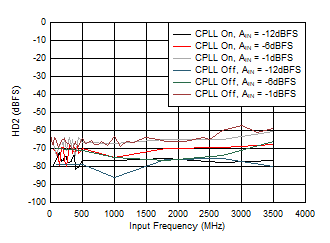 Figure 8-52 HD2
vs AIN and C-PLL
Figure 8-52 HD2
vs AIN and C-PLL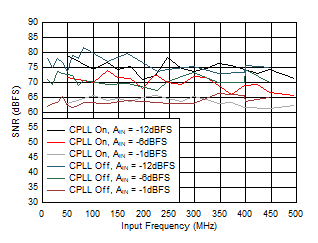 Figure 8-54 SFDR
vs AIN and C-PLL
Figure 8-54 SFDR
vs AIN and C-PLL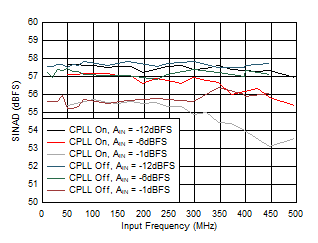 Figure 8-56 SINAD
vs AIN and C-PLL
Figure 8-56 SINAD
vs AIN and C-PLL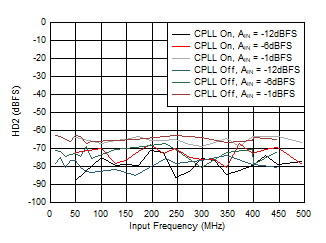 Figure 8-58 HD2
vs AIN and C-PLL
Figure 8-58 HD2
vs AIN and C-PLL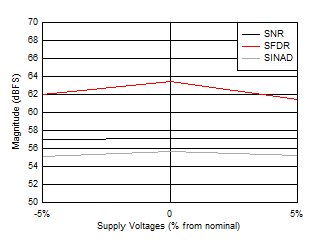
| All
supplies changed together, high power mode |
Figure 8-60 SNR,
SFDR and SINAD vs Supply Voltage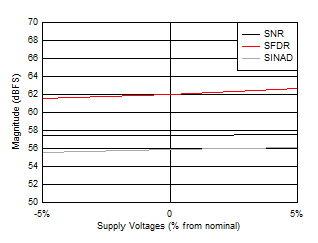
| All
supplies changed together, low power mode, FS
= 1000MSPS |
Figure 8-62 SNR,
SFDR and SINAD vs Supply Voltages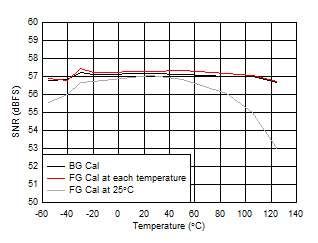 Figure 8-64 SNR
vs Temperature
Figure 8-64 SNR
vs Temperature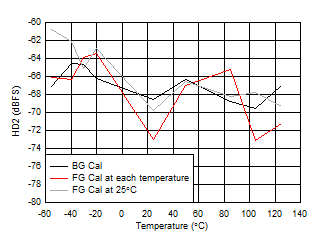 Figure 8-66 HD2
vs Temperature
Figure 8-66 HD2
vs Temperature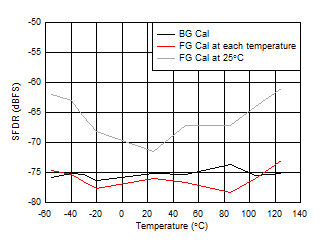
| Worst spur is non-HD2 though -HD10 SDFR |
Figure 8-68 Worst
Spur vs Temperature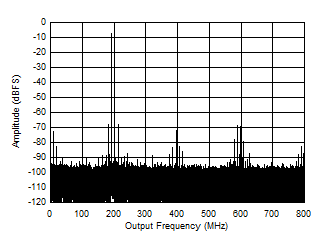 Figure 8-70 Two
Tone FFT at 1798MHz
Figure 8-70 Two
Tone FFT at 1798MHz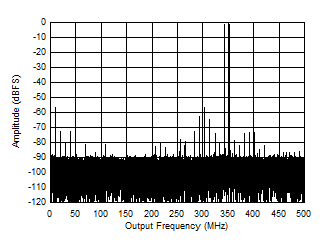
| 10
MHz tone spacing, -7 dBFS per tone, Low power mode,
1000MSPS |
Figure 8-72 Two
Tone FFT at 348 MHz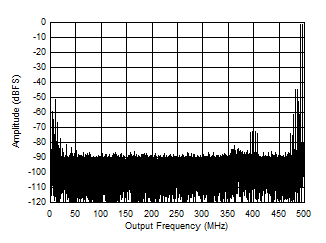
| 10
MHz tone spacing, -7 dBFS per tone, Low power mode,
1000MSPS |
Figure 8-74 Two
Tone FFT at 3498 MHz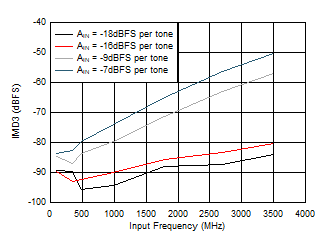
| 10MHz tone spacing, Low power mode, 1000MSPS |
Figure 8-76 IMD3
vs FIN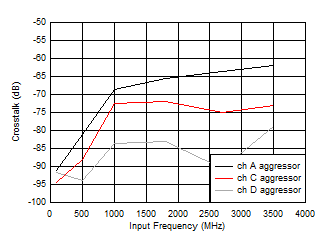 Figure 8-78 Crosstalk to Channel B vs FIN
Figure 8-78 Crosstalk to Channel B vs FIN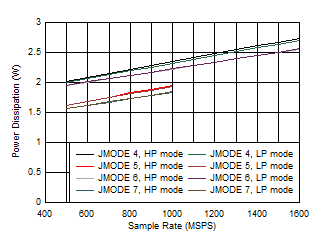
| Low
power background calibration mode |
Figure 8-80 Quad
Channel, Power Dissipation vs FS and JMODE 4 - 7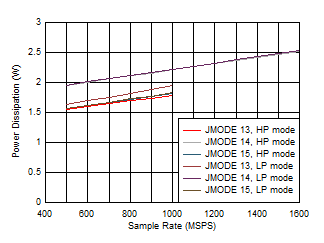
| Low
power background calibration mode |
Figure 8-82 Quad
Channel, Power Dissipation vs FS and JMODE 13 - 15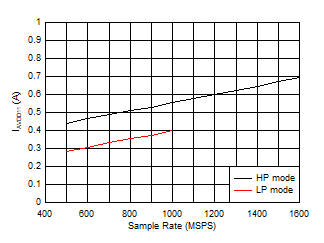
| Low
power background calibration mode, independent of
JMODE |
Figure 8-84 Quad
Channel, IVA11 vs FS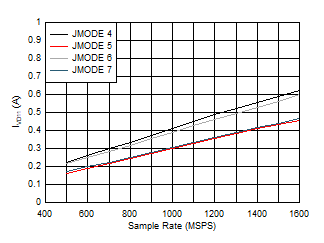
| Low
power background calibration mode, independent of power
mode |
Figure 8-86 Quad
Channel, IVD11 vs FS and JMODE 4 - 7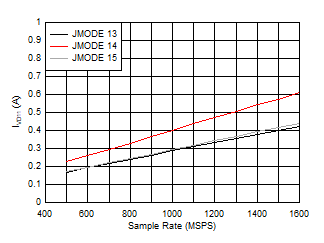
| Low
power background calibration mode, independent of power
mode |
Figure 8-88 Quad
Channel, IVD11 vs FS and JMODE 13 - 15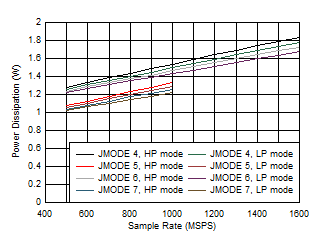
| Low
power background calibration mode |
Figure 8-90 Dual
Channel, Power Dissipation vs FS and JMODE 4 - 7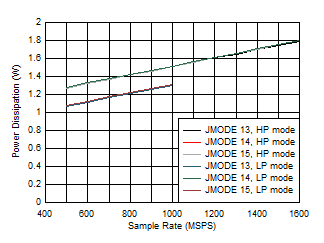
| Low
power background calibration mode |
Figure 8-92 Dual
Channel, Power Dissipation vs FS and JMODE 13 - 15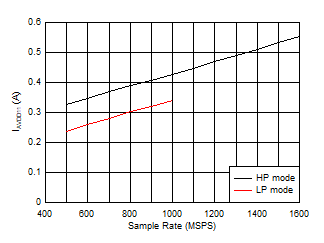
| Low
power background calibration mode, independent of
JMODE |
Figure 8-94 Dual
Channel, IVA11 vs FS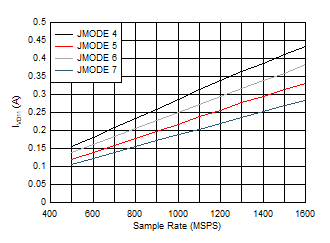
| Low
power background calibration mode, independent of power
mode |
Figure 8-96 Dual
Channel, Power Dissipation vs FS and JMODE 4 - 7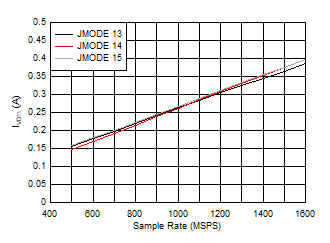
| Low
power background calibration mode, independent of power
mode |
Figure 8-98 Dual
Channel, Power Dissipation vs FS and JMODE 13 - 15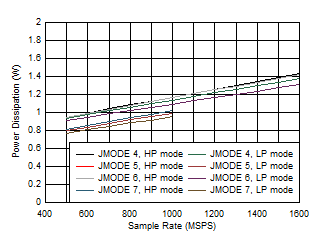
| Low
power background calibration mode |
Figure 8-100 Single Channel, Power Dissipation vs FS and JMODE 4 - 7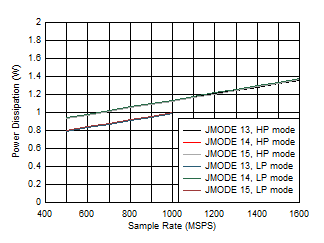
| Low
power background calibration mode |
Figure 8-102 Single Channel, Power Dissipation vs FS and JMODE 13 -
15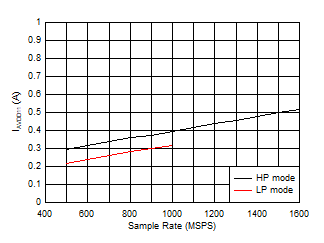
| Low
power background calibration mode, independent of
JMODE |
Figure 8-104 Single Channel, IVA11 vs FS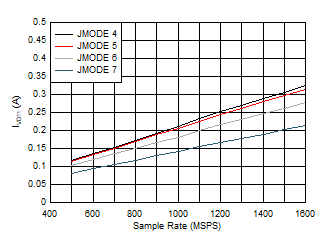
| Low
power background calibration mode |
Figure 8-106 Single Channel, IVD11 vs FS and JMODE 4 - 7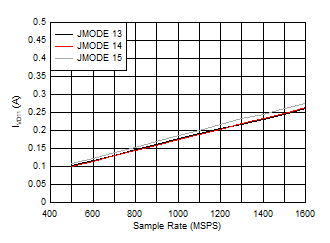
| Low
power background calibration mode |
Figure 8-108 Single Channel, IVD11 vs FS and JMODE 13 - 15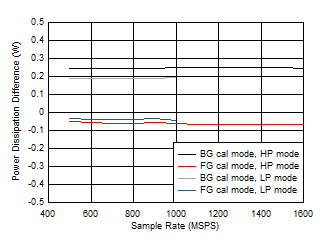
| Difference to lower power background calibration, JMODE
independent |
Figure 8-110 Dual
Channel, Power Dissipation Change with Calibration Mode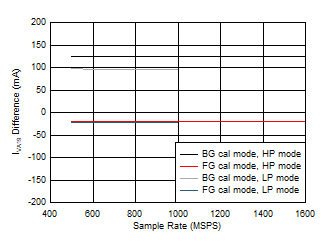
| Difference to lower power background calibration, JMODE
independent |
Figure 8-112 Quad
Channel, IVA19 Change with Calibration Mode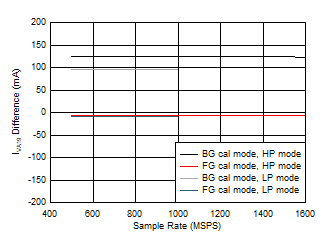
| Difference to lower power background calibration, JMODE
independent |
Figure 8-114 Single Channel, IVA19 Change with Calibration Mode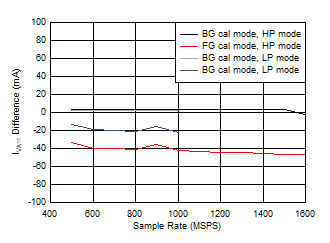
| Difference to lower power background calibration, JMODE
independent |
Figure 8-116 Dual
Channel, IVA11 Change with Calibration Mode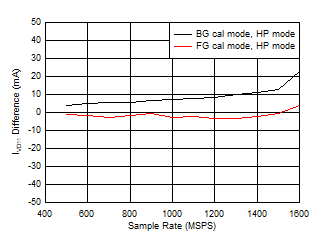
| Difference to lower power background calibration, JMODE
independent |
Figure 8-118 Quad
Channel, IVD11 Change with Calibration Mode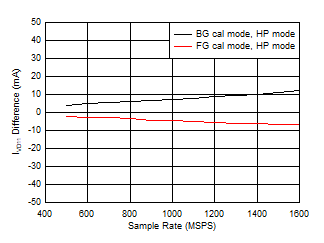
| Difference to lower power background calibration, JMODE
independent |
Figure 8-120 Single Channel, IVD11 Change with Calibration Mode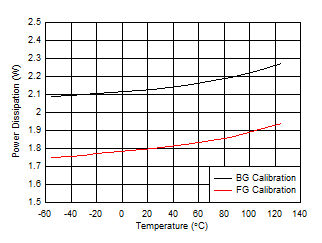 Figure 8-122 Dual
Channel, Power Dissipation vs Temperature
Figure 8-122 Dual
Channel, Power Dissipation vs Temperature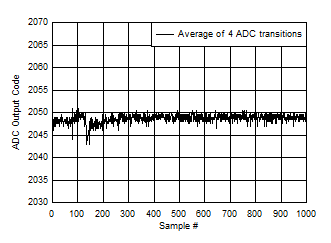
| BG
Calibration, midscale input voltage, ADC_SRC_DLY=31,
MUX_DLY=30 |
Figure 8-124 Background Calibration Core Transition (midscale voltage)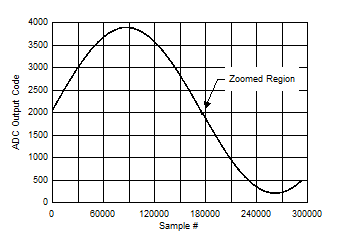
| BG
Calibration, ADC_SRC_DLY=31, MUX_DLY=30, zoomed region
shown in next plot |
Figure 8-126 Background Calibration Core Transition (AC Signal)






























































































































